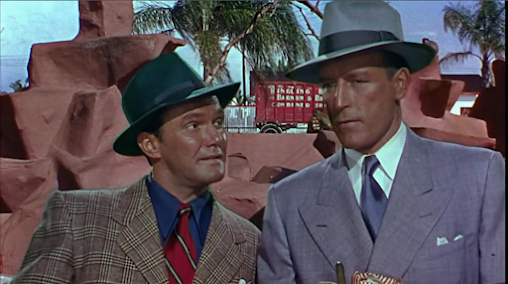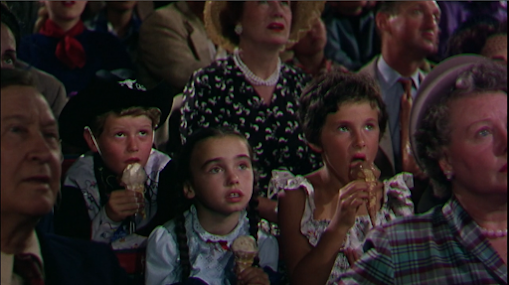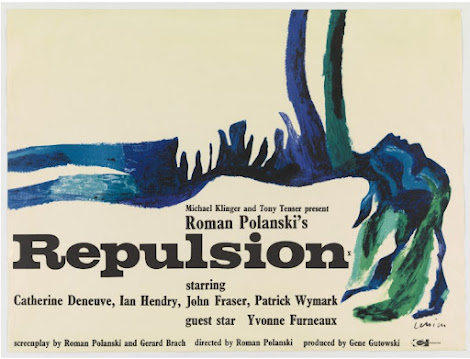This post is my contribution to the Classic Movie Blog Association's blogathon "Screen Debuts and Last Hurrahs." Go here for links to all the posts from the best classic film bloggers you'll ever meet!
He probably didn't know it, but in the late 1940s Cecil B. DeMille was beginning his last act as a Hollywood director, perhaps the most powerful one the relatively new industry had ever known. He had completed the founding of what was to become Paramount Studios; had shepherded the industry from films done in pantomime to those with recorded sound and speech; had moved to MGM and then back to Paramount; had ended a nine-year run as the host of the Lux Radio Theater, where so many stars reprised their movies for listening audiences; and was revered, and sometimes reviled, for his epic, imaginative, audience-pleasing movies.
Inspired by Scott Eyman's excellent biography, Empire of Dreams: The Epic Life of Cecil B. DeMille, I decided to fill in some of my viewing gaps in his filmography, especially the two films immediately preceding The Ten Commandments. (Thank you, ABC-TV, for airing that one every spring!) In contrast, both Samson and Delilah (1949) and The Greatest Show on Earth (1952) had no such TV presence when I was growing up, despite their being "big" films, one even an Academy Award Best Picture winner. So I watched them. Read on for my take on these films and an attempt to put them in the context of DeMille's final years as a director.
Behind the Scenes: The Making of Samson and Delilah (1949)
Samson came after ten years of films about Americana for DeMille. He had been particularly discouraged by the failure of his previous picture Unconquered, and he took a bit of solace in returning to the genre that yielded his favorite film, King of Kings, the epic tale of the gospels from 1927. Apparently, DeMille sold Paramount executives on the commercial potential of the Samson and Delilah story by showing them a painting of a strong man in a loincloth with a scantily clad beauty. The casting process for Samson and Delilah brought together a fascinating mix of talent. In addition to the exotic Hedy Lamarr (who beat out Jean Simmons) and Victor Mature (who was chosen over Burt Lancaster because DeMille liked him in Kiss of Death) in the leads, Henry Wilcoxen, a close friend of DeMille, was cast, as were Angela Lansbury, George Sanders, and DeMille's longtime mistress Julia Faye. It was also the first substantial part for the young Russ Tamblyn, 14 years old at the time of filming.
 |
| DeMille (with visor) on the set with Lamarr and Mature |
During production, DeMille had the opportunity to reminisce about his early career, now decades behind him. Biographer Eyman highlights how DeMille attended the opening of a bank on the site (the corner of Selma and Vine) of the former silent-era studio he ran with Jesse Lasky. Also attending were silent luminaries Theda Bara, Ramon Navarro, Mack Sennett, and Francis X. Bushman, among others. DeMille said, "I was in doubt (in those days) that there would be a bank in Hollywood!"
 |
| Young Russ Tamblyn (upper right) played the future king Saul as a youth in a substantial supporting role. DeMille bullied him at times on the set, leaving him with some unpleasant memories. |
To this viewer, the dramatic acting and commanding presence of the cast compensated for the rather stilted script, resulting in an overall enjoyable movie. DeMille's opening narration, a trademark of his films, set the tone, while Victor Young's score added a rich, exotic tone to the narrative. The theme of freedom from bondage, once again foreshadowing The Ten Commandments, underscored the film's dramatic arc. The film's love triangles (Senadar--Samson--Delilah and Samson--Delilah--Saran) offer evidence of DeMille's penchant for ratcheting up the biblical sex angle on full display later in The Ten Commandments.
The impressive (although clearly artificial) sets brought to mind a fascinating piece of cinema history that I hadn't known before reading DeMille's bio: after the filming in 1923 of the first The Ten Commandments, the entire outdoor set was destroyed and buried in the dunes in central California and was only found and excavated starting in the 1980s. Read more here.
A few additional observations are provided in the screenshot captions below.
 |
| "No man leaves Delilah!" Hedy Lamarr and Mature make a beautiful couple, each bringing appropriate exoticism and intensity. |
 |
| George Sanders is strong here as Samson's nemesis, the Philistine emperor, the Saran. Very few films don't benefit from his presence. |
 |
| Samson topples the temple -- a DeMille-worthy heart-stopping finale. |
 |
| DeMille's attention to detail: look at Sanders in the lower middle of this shot; he's the only one noticing something might be amiss with blind Samson leaning against the temple pillars. |
 |
| Angela Lansbury (as the Philistine Semadar) did not have enough screen time, IMO. Here she is with Mature (left) and Wilcoxen. |
Samson and Delilah was a great success, making back over three times its $3 million budget. It won Oscars for costumes (the great Edith Head), art direction (Hans Dreier), and was nominated for score (Victor Young), special effects, and cinematography.
The Greatest Show on Earth (1952): The Circus meets the movies
After Samson & Delilah, DeMille found himself in a protracted battle with the Directors Guild of America (DGA), wanting them to institute a "loyalty oath" during the peak of the blacklist era. DeMille, a conservative, was ultimately deposed from the Board of the DGA, after a series of contentious meetings that biographer Eyman describes in great detail. Yet, he hung on to his career despite a lukewarm response from critics to Samson and Delilah and much of his sound-era filmography. In the 1950s, DeMille benefited from a wave of critical reappraisal from France. In the Cahiers du Cinema, Jacque Doniol-Valcroze wrote in 1951:
"The man has his faults...but it appears to me that his outstanding quality, spanning the whole length of an abundant career, is an almost total unity of style, a constant fidelity to one perspective, and a conception of history of the plastic arts and literature, a conception he did not originate on the screen but of which he was perhaps the most important and talented popularizer."
It seems that the DeMille we appreciate in 2024, the DeMille of legend, was beginning to take shape.
DeMille's next film, The Greatest Show on Earth (in 1952, sandwiched between Samson and The Ten Commandments), allowed him to explore contemporary themes of entertainment and human drama within the vibrant, chaotic setting of the circus in contemporary America.
 |
| Opening credits for The Greatest Show on Earth |
DeMille was fascinated with the circus, and even during the production of Samson and Delilah he spent days visiting the Ringling Bros. operation, observing the behind-the-scenes workings of the circus, and knew he could make a picture to do it justice. Paramount went into negotiations with the Ringling Co. to establish a partnership for the film, in exchange for upfront payments and royalties over 20 years. And he created a star of Charlton Heston by casting him in the lead role of Brad Braden, the circus manager. Henry Wilcoxen, promoted to associate producer, suggested him, but DeMille's first reaction, after seeing Heston in Dark City, was that he was too dour. He changed his mind when Heston happened to drive by DeMille's office and waved in an apparently charming, light-hearted way. He got the job without a screen test.
The making of The Greatest Show on Earth was itself a spectacular endeavor. In addition to Heston, several other stars signed up for important roles: Betty Hutton; Cornel Wilde; James Stewart in one of his oddest roles as a clown hiding a dark secret; Gloria Grahame; and Dorothy Lamour, who must have been past her starring days as her role was quite small. Julia Faye and Henry Wilcoxen again appeared. The film also included cameos from Paramount stars like Bob Hope and Bing Crosby, adding a touch of Hollywood glamor. Most scenes were filmed on location traveling with the circus.
DeMille's opening narration immediately immerses the audience in the world he meticulously crafted. DeMille stepped in several more times for narration between acts of the film. Victor Young's score once again provided a lush musical backdrop, enhancing the film's emotional and dramatic impact. The film offered authentic behind-the-scenes views of circus production and gave the audience plenty of time to enjoy a variety of circus acts (trapeze! parades! clowns! songs!) and animals of all kinds: elephants, lions, hippos, chimps, giraffes...adding to its authentic feel.
However, not everything in the film worked perfectly for me. Betty Hutton, while energetic, came off as a bit too perky and brash, and I found the love interest narrative between her character and those of Heston and Wilde (another triangle!) tiresome and confusing. She seemed to be in love with whoever was more vulnerable in any given moment and flitted back and forth with little provocation. And neither Heston nor Wilde seemed to do more than condescend to her. Additionally, Lawrence Tierney's appearance in an underdeveloped gangster plot felt like it was cut in from another film entirely. I captured further observations in the screenshots below.
 |
| Lawrence Tierney (right) is up to no good. I never understood why this plot line was shoe-horned into the movie, other than to catalyze a spectacular train wreck near the movie's end. |
As expected, The Greatest Show on Earth was another success for DeMille and Paramount. This one finally won DeMille his Best Picture Oscar, if perhaps it was a "lifetime achievement" type of award. A legendary director of another generation, Steven Spielberg, said that seeing this film in a cinema as a child was the "greatest thing that ever happened to him;" he recreated this time in his life in his film The Fabelmans (see this link for Spielberg talking about that experience).
This Post's "Last Hurrah"
Watching and reading about these films, I'm convinced that Samson and Delilah and The Greatest Show on Earth are fitting examples of DeMille's mature cinematic style, which he had perfected at this time in his career (and would reach its apex in The Ten Commandments, the final film he directed). I enjoyed Samson and Delilah more, but will concede that both films are entertaining, no doubt even more on the big screen. DeMille was obviously a complicated and controversial figure, both during his lifetime and today, but due to his drive, artistic vision, and perseverance, his place as one of Hollywood's greatest filmmakers is secure.
Once again, this post is contributed to the CMBA's blogathon "Screen Debuts and Last Hurrahs". Go here for links to all the posts.











































